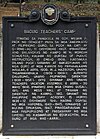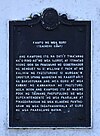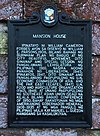| Marker title | English Translation | Category | Type | Description | Location | Language | Date Issued | Image |
|---|
| Baguio City Hall | | Building/Structures | Government Center | First built in 1910 under E.W. Reynolds, the first mayor of the city. Where the Japanese flag was flown on December 27, 1941 to signal their occupation. | Baguio City Hall, Baguio | Filipino | September 2, 2009 |  |
| Baguio Country Club | | Building | Social Club | Established by William Cameron Forbes in 1905. Judge Roman Ozaeta became first Filipino president in 1957. | Baguio Country Club, Baguio | Filipino, English | February 18, 2005 | |
| Baguio Teachers' Camp | | Association/ Institution/ Organization | Institutional marker | Used as a vacation site for teachers. Established on December 11, 1907. Formerly known as O-Ring-Ao. | Teachers' Camp, Baguio | Filipino | 2008 |  |
| Ang Bell House at ang Bell Amphitheater | The Bell House and the Bell Amphitheater | | | Built as a vacation house of American governor-generals. | Camp John Hay, Baguio City | Filipino | October 25, 2023 [2] | |
| Benguet State University | | | | Started as a farm school in 1916. Spearheaded secondary and agricultural indigenous education. | Centennial Park, Benguet State University, La Trinidad, Benguet [3] | Filipino | September 27, 2016 [4] | |
| Brent School | | | | Founded in 1909 by Bishop Charles Henry Brent as Baguio School for Boys. | Brent School, Baguio | Filipino, English | March 15, 2008 |   |
| Casa Vallejo | | | | Built in 1909 to house the workers of Baguio. | Casa Vallejo | Filipino | September 20, 2019 |  |
| Dating Kinatatayuan ng Akademya Militar ng Pilipinas | Former Site of Philippine Military Academy | Association/ Institution/ Organization | Institutional marker | Became the site of the Philippine Military Academy from June 15, 1936 until December 12, 1941. | Teachers' Camp, Baguio | Filipino, English, | February 19, 1994 |  |
| Dating Kinatatayuan ng Constabulary School (Ngayo'y Philippine Military Academy) | Former Site of Constabulary School (Now Philippine Military Academy) | | | Became the site of the Philippine Constabulary School from 1908 to 1935 and 1947 to 1950. | Camp Henry T. Allen, Baguio | Filipino | February 17, 1996 |  |
| Dominican Hill and Retreat House (1915) [5] | | | | Built as a Dominican retreat house, became the refuge of Dominican priests and their families during WWII. | Dominican Hill, Baguio | Filipino | September 1, 2014 |  |
| Easter College | | | | Established in 1906 by Charles Henry Brent for the schooling of children from Mountain Province. Became a Japanese outpost during WWII. | Easter College, Baguio | Filipino | December 12, 2017 | |
| Kampo ng mga Guro (Teachers' Camp) | | Building | Group of Houses | Used as a vacation site for teachers. Known before by the Igorots as O-Ring-Ao | Teachers' Camp Rd. Teachers' Camp, Baguio | Filipino | Between May 6–15, 1968 [6] |  |
| Mansion House | | Building | House | Constructed in 1908 to be used as a summer residence of the chief-executive. | Mansion House Site, Baguio | English | 1951 | |
| Mansion House | | | | Constructed as part of the Burnham plan of Baguio. Inspired by the city beautiful movement. | Mansion House Gate, Baguio | Ilocano, Filipino, English | December 30, 2008 [7] [8] |    |
| Philippine Commission's First Session in Baguio | | Site | Site | Site where Baguio was officially declared as the Summer Capital of the Philippines. | Gov. Pack Road, Baguio | English | 1940 |  |
| Philippine Military Academy [9] | | Association/ Institution/ Organization | Institutional marker | Recognized as the successor to the Academia Militar of Barasoain, Malolos, Bulacan | Camp General Gregorio del Pilar, Baguio | Filipino | May 21, 2019 | |
| Signing of the Japanese Capitulation Document | | | | Where the document was signed for the surrender of the Japanese Imperial Forces in the Philippines. | Camp John Hay site, Baguio | English | 1946 | |
| United Church of Christ in the Philippines (UCCP Baguio) | | Building/Structures | House of Worship | One of the first Protestant churches in Northern Luzon, established on February 11, 1911. | UCCP Baguio, Baguio | Filipino | February 11, 2012 |  |
| United States Embassy Residence Baguio | | Building/Structures | Building | Erected in 1940. Occupied by the Japanese, but were forced out later further to the mountains. | Camp John Hay, Baguio | English | September 3, 2005 | |

















